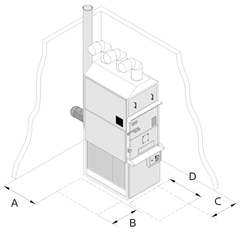Flue & Chimney Connection

| A | Insulated Chimney |
| B | Storm Collar |
| C | Roof flashing |
| D | Roof support to retain chimney |
| E | Twin wall to single wall adaptor |
| F | Single wall flue pipe. Twin wall is also suitable |
| G | Wall support. Retains internal flue |
| H | Internal bends |
| I | Flue starter kit |
| J | Flue to adaptor |
| K | Debris trap for falling soot (with water drain point in the end cap) |
| L | Flue support stand |
Single wall or Twin wall chimney
Single wall chimney may be used inside a building however we would recommend twin-wall insulated chimney.
Access for cleaning
Good access for cleaning must be included in the chimney system.
Connection to the rear of the appliance
- The F28 is only available as a natural draught chimney model. This is commonly fitted with a 90deg bend at the rear to allow for a vertical rise of the chimney.
- The F55 and F85 models can be supplied with natural draught chimney versions or our recommended flue fan versions.
- Whichever version is chosen we would recommend the first connection is a T pipe of 90deg or better still a 135deg T pipe.
Chimney support
The weight of the chimney should be supported by a stand (item L in the diagram) and not the rear of the appliance.
Bends in a chimney
These should be kept to a minmium. Where a bend is needed it should be of no more than 45deg.
Chimney cowl
We do not recommend a chimney cowl as this can slow the volume of flue gasses. We recommed a cap of the connecting T pipe to include a drain point. This drain will allow any excess rain which enters chimney to exit the chimney system.
See our range of twin wall, stainless steel, acid resistant flue kits and flue components here.
Routing Chimney through roof
There are several different methods to pass through a roof.
- The chimney must be supported as it passes through the roof. Commonly roof support is used.
- Any wood or flammable material MUST be at least 2" 50mm away from the outside of the twin wall insulated chimney pipe. (refer to chimney manufacturer).
- Prevent water ingress. A roof flashing should be used.
- In heavy weather conditions, it is possible to rainwater can leak between chimney and flashing seal. Use a storm collar attached above the flashing.

